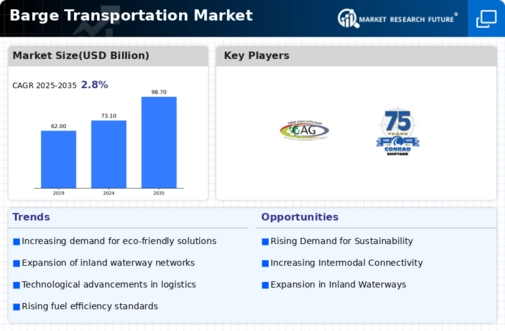Market Growth Projections
The Global Barge Transportation Market Industry is poised for growth, with projections indicating a market size of 73.1 USD Billion in 2024 and an anticipated increase to 98.7 USD Billion by 2035. This growth trajectory suggests a compound annual growth rate (CAGR) of 2.77% from 2025 to 2035. Such figures underscore the industry's resilience and adaptability in the face of changing market dynamics. The increasing demand for efficient and sustainable transportation solutions is likely to drive this growth, as stakeholders recognize the advantages of barge transportation in the global supply chain.
Growing Demand for Bulk Transportation
The Global Barge Transportation Market Industry experiences a growing demand for bulk transportation of goods, particularly in regions with extensive inland waterways. This trend is driven by the need for cost-effective and environmentally friendly logistics solutions. Barge transportation offers a lower carbon footprint compared to road and rail transport, making it an attractive option for companies aiming to reduce emissions. In 2024, the market is projected to reach 73.1 USD Billion, reflecting the increasing reliance on barges for transporting commodities such as coal, grain, and chemicals. This shift towards sustainable transport solutions is likely to bolster the industry's growth in the coming years.
Infrastructure Development Initiatives
Infrastructure development initiatives play a crucial role in enhancing the Global Barge Transportation Market Industry. Governments across various countries are investing in the improvement of inland waterways, locks, and terminals to facilitate smoother barge operations. For instance, the U.S. Army Corps of Engineers has been actively involved in maintaining and upgrading the navigability of major rivers, which is vital for barge traffic. Such investments not only increase the efficiency of barge transportation but also attract more businesses to utilize this mode of transport. As infrastructure continues to improve, the market is expected to expand, potentially reaching 98.7 USD Billion by 2035.
Rising Fuel Costs and Economic Factors
Rising fuel costs and various economic factors are reshaping the Global Barge Transportation Market Industry. As fuel prices fluctuate, businesses are increasingly seeking cost-effective transportation solutions to maintain their profit margins. Barge transportation, known for its fuel efficiency, offers a competitive edge over other modes of transport. This economic pressure encourages companies to shift towards barges for moving large quantities of goods over long distances. The industry's ability to adapt to changing economic conditions may further solidify its position in the logistics sector, ensuring continued relevance in a dynamic market landscape.
Regulatory Support for Sustainable Practices
Regulatory support for sustainable practices significantly influences the Global Barge Transportation Market Industry. Governments are increasingly implementing policies that encourage the use of environmentally friendly transportation methods. For example, initiatives aimed at reducing greenhouse gas emissions have prompted companies to consider barge transportation as a viable alternative. This regulatory environment fosters innovation and investment in cleaner technologies, which may enhance operational efficiency and reduce costs. As the industry adapts to these regulations, it is likely to see a steady growth trajectory, with a projected CAGR of 2.77% from 2025 to 2035, indicating a robust future for barge transportation.
Technological Advancements in Navigation and Operations
Technological advancements in navigation and operations are transforming the Global Barge Transportation Market Industry. Innovations such as automated navigation systems, real-time tracking, and improved communication technologies enhance the efficiency and safety of barge operations. These advancements not only streamline logistics but also reduce operational costs, making barge transportation more appealing to businesses. As technology continues to evolve, it is expected that the industry will witness increased productivity and reduced transit times, thereby attracting more stakeholders to invest in barge transportation solutions.













